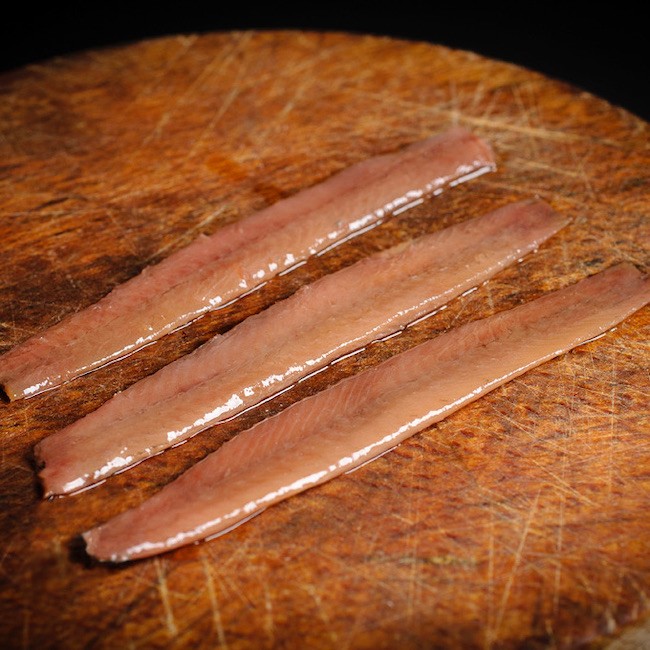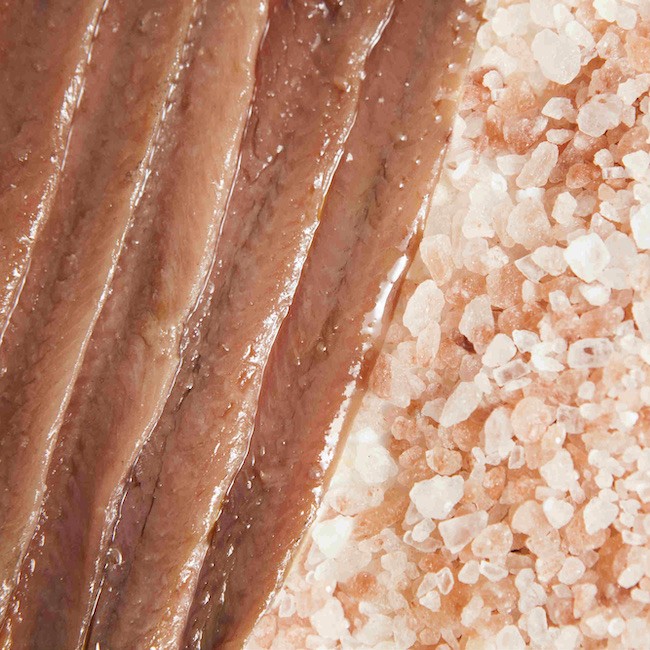.png.transform/rendition-xs/image_image%20(1).png)
The Anchovy, Aristocracy in (Semi-) Preserved Form
In the last few decades, anchovies have gone from being a humble snack to a delicacy. This is attributable to companies focusing on quality and their skilled craftsmanship.
The need to preserve food can give rise to gastronomic masterpieces. This is the case of the salt-cured anchovy, created from the fresh anchovy, a blue fish that's related to the sardine and which, once salted, is its most perfect version. But the anchovy, which is considered a true gourmet delicatessen, hasn't always enjoyed as much fame and recognition as it does today. A modest level of quality, a less-than-meticulous cleaning and a curing process that did not always adequately remove the salt led people to form an opinion in their minds: that anchovies were simple a mediocre product. But that's all in the past, and those anchovies, which had too much flavor and a rough texture, have nothing to do with today's anchovies, which are available in the best gourmet shops.

It's as simple as opening a can of quality anchovies to fall under the spell of this unique fish. The fillets are skillfully placed in the can, free of bones and other unpleasant elements. The texture is silky, tasty and with just the right amount of salt. A perfect bite that pairs wonderfully with beer, white wine or sherry.
The irresistible ascent of this semi-preserve—yes, it needs to be cold as it isn't subjected to heat sterilization—is well known in Cantabria, where they produce what are perhaps the most highly prized anchovies on the peninsula, specially in the village of Santoña. According to the Controlled Quality seal created by the local government, the anchovy must be of the Engraulis encrasicholus species and it must have been fished in the Cantabrian Sea in the spring. "The months leading up to the summer are the best for obtaining a fish with the perfect balance between fat and texture. The Cantabrian Sea is a kind of natural gym for the anchovy and the result is a fantastic product," explains Fidel Ortiz, Director of Codesa, a leading quality anchovy brand. He says that the evolution of the product and the company has been "tremendous" in recent decades, although there is still a considerable lack of information, especially outside Spain: "Often at fairs there are people who automatically think of it as a very salty, low-quality product, but that disappears after the first bite," adds Ortiz.
Despite having a staff of around 100 people, Codesa works with anchovies using "artisan techniques, as we have always done," says Ortiz. After catching anchovies and selecting them, the process is as follows: once the fresh anchovies arrive at the factory, they are quickly pressed with saltwater so that they harden, the heads are removed one by one, and they and placed in 300 kilogram barrels where they are cured for a whole year. "Those that are eaten in 2021 were caught in 2020, and so on," says Fidel.
Then the anchovies' skins, excess salt and moisture are all removed, and they're ready for the sobadoras to work their magic. Sobadoras, traditionally women, are the ones who very carefully separate the two fillets, remove the central spine and place them perfectly in a tin so they're ready to be enjoyed. At Codesa, they recognize this meticulous and important job by including a small piece of paper in the tin with the name of the person who made it possible for us to enjoy the anchovy with our vermouth. It's a nice touch to know that María del Carmen or Paloma made our appetizer possible!

There's no doubt about how to eat it: it's perfect on its own, although Ortiz points out that it goes well with a slice of tomato, the fat from an avocado or some soft cheese. "I have a certain weakness for a matrimonio, a pintxo which combines a salt-cured anchovy with an anchovy marinated in vinegar. It's an irresistible combination." Of course, he recommends that salt-cured anchovies be eaten on their own so as to appreciate their smoothness and balance. Another bit of expert advice: take them out of the refrigerator a few minutes before eating them so that the liquid smoke flavor returns to the oil and the product adjusts slightly: eating it when it's between 17-18 degrees is ideal.
From Cantabria to L’Escala
And from coast to coast. While Cantabrian anchovies are famous, so too are those from L'Escala, a charming little fishing village that knows plenty about this fish. "The area's ties to anchovies go back to the time of the Greeks, who were great merchants and were producing this salted fish. There's evidence from this period in the form of amphorae with remains of salt in which there were anchovies since time immemorial," says Rosa Hostenc, from Anxoves (anchoas in Catalan) Solés, a family-run business that has a small museum at its factory.
Over time, L'Escala went from being a small village that lived off the sea to a key tourist spot on the Costa Brava, just a stone's throw from Bajo Ampurdán. Today, small factories such as the Solés one are still on the outskirts and choose the town for their tempting gourmet shops. "It's incredible how much consumers' appreciation of anchovies has changed," says Hostenc, who recalls that "decades ago anchovies were rubbed on bread and they were given almost zero importance."
In L'Escala, they also source anchovies from the Cantabrian coast to produce their renowned (semi-)preserves. The keys to their success are simple: "Find for the best quality anchovies, cure them well and clean them even better," says Hostenc. Their customers today are visitors, many of them French (the border is about 60 kilometers away) who choose this charming spot to relax and try some delicious anchovies while they're there. If the ancient Greeks were to take a peek, they would be amazed at how far this little blue fish has come...
Author: Javier Sánchez / @ICEX

